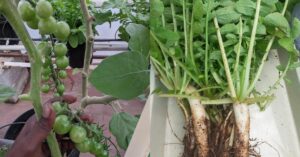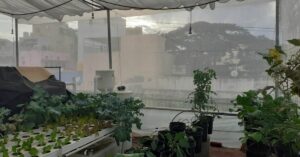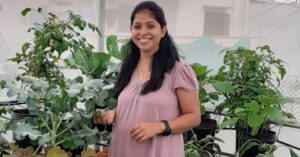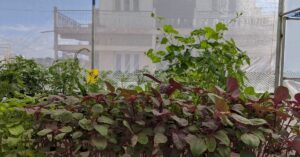Amidst the chaos of Bengaluru traffic, on a rooftop in Richards Town, you will find Jincy Samuel’s terrace dotted with a rainbow of colours, from purple and burgundy to green. If you look closely you may notice it is not a typical garden lined with flower beds, it has prawns and tilapia fish that mingle with the vegetable and herb plants.
Jincy is growing her plants using novel methods like hydroponics and aquaponics that are a shift away from the typical soil-based methods.

Putting fish to work
As the country went into a lockdown in March last year, it became a common sight to see people queuing up in large numbers outside supermarkets. It was during this time, Jincy’s husband, Benson Samuel, suggested they start growing their own food. “During the lockdown, we had to go and stand in long queues at grocery shops, which was tiring. My mother-in-law and I have always been fond of gardening but the lockdown proved to be a game-changer for us,” says Jincy.
Neither Jincy nor her husband has any formal training in agriculture. Jincy holds an MBA and has professional experience working at BPO’s, running a cryptocurrency platform and has worked in the food sector while her husband has worked in the technology industry.
Since Jincy and her husband were both self-employed and with no prior training on how to grow their food they began taking out time to study the possible methods they could use. They were drawn to the methods of hydroponics and aquaponics due to two reasons.
Firstly, the limited space available and, secondly, the rate of growth as compared to traditional soil-based gardening.

“The hydroponic system can easily be set up in an urban household. I have compared growing plants using soil versus hydroponics. I have found that the growth is faster since the environment is more controlled. As you have the polyhouse there are no pests that come and attack the plants and at the same time you can control what nutrients the plant receives. This gives better results than soil-based gardening,” says Jincy.
In hydroponics, a nutrient-charged, aquatic solution is flushed through the roots of the plant to provide the necessary resources for optimal growth. “In the hydroponic system, there is a reservoir where you add water along with basic nutrient salts such as potassium and nitrogen, in proportion to what the plants require and how much water is used,” explains Jincy.
Aquaponics, on the other hand, is a combination of aquaculture and hydroponic systems. It utilises the waste of one element to benefit another thus mimicking a natural ecosystem.
Jincy explains how the aquaponic system in her house works. She says, “You grow edible fish in the system, so you get your meat, if you want to harvest it. The water then passes through a mineralisation tank and gets treated. This treated water is then used to grow the vegetables. This is a recirculating system.”
In essence, hydroponics and aquaponics replace the soil with water and use a controlled growth environment such as a polyhouse to prevent pests and insects from attacking the plants.
Trial and error learning
Before setting up their polyhouse, the couple reached out to companies in the city that supply hydroponic and aquaponics systems, like Hydrilla and Garden Guru, to understand the space better. It was in May 2020, that they first had the system’s setup and began their journey.
Setting up the systems, however, was only the first step. As they began planting vegetables and fruits they soon came to understand that growing food requires a certain level of planning and regular care. “When I started, I grew spinach in about 96 pots. Soon, there was so much spinach, I didn’t know what to do with it! That was a disastrous idea. But with time, we have figured out there is a way to plan,” says Jincy.
Today, Jincy grows about 200 to 230 varieties of plants on her 500-square-foot terrace. Vegetables such as brinjals, cherry tomatoes, spinach, kale, radish, mint, okra, and exotics like red lettuce, iceberg lettuce and broccoli are a few of the plants Jincy grows along with breeding aquatic animals like prawns and tilapia fish.
“When we started during the lockdown it gave us purpose, it kept us engaged and it was absolutely exciting getting our hands dirty and setting up everything, growing your food and consuming it, this was an experience like no other,” says Jincy.

As Jincy gained experience with each cycle of vegetables that were grown, she soon realised that the amount they produce is more than what was required for her family’s consumption. This led her to start selling the excess produce to neighbours and to an organic store in the city that is more than happy to take her high quality produce. She makes around Rs 3,000 to Rs 4,000 per month by selling the excess produce.
Jincy’s homegrown vegetables are a class apart from store-bought ones. When neighbours and guests at their home pop a cherry tomato in their mouths, they’re surprised to find it’s fresh and juicy taste.
Growing her vegetables has not only improved the quality and taste of the food her family consumes but also encouraged them to eat healthier.

Jincy says, “My husband was a total non-vegetarian and would not touch veggies for the past 13 years of our marriage. But when we started growing our food he started eating them and that’s a huge change.”
On popular demand from customers and neighbours, she helps set up a similar system in people’s homes and makes hobby kits for beginners to guide them through the journey of setting up their own hydroponic and aquaponic systems.
Jincy believes that the key is to start small, see what works and then expand as you learn the process better.

While work keeps Jincy and her husband busy she makes it a point to check up on her garden daily. “It’s such a different experience when you first plant the seeds and watch them grow and mature. It brings me immense joy,” says Jincy.
Edited by Yoshita Rao
No comments:
Post a Comment